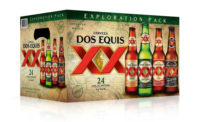As premiumization continues to impact the beer market, imported beers have found favor with consumers. Jeff Nowicki, chief strategy officer with Bump Williams Consulting (BWC), Stratford, Conn., says imports saw improvements in both volume and dollar sales in 2014, with volume up 6.5 percent and dollar sales increasing by 8.2 percent, based on data from Chicago-based Information Resources Inc. (IRI) in U.S. multi-outlets and convenience stores. Danelle Kosmal, vice president of the beverage alcohol practice for New York-based Nielsen, reports similar numbers, with case sales up 5.8 percent and dollar sales increasing 8.2 percent in 2014.
Although imported beer sales performed well in 2014, the success can be attributed to a select number of segments. “While most segments of imported beer are experiencing declines, Mexican imports continue to grow and are the primary driver of total imports growth over the past several years,” Kosmal says. “In 2014, Mexican import beers were up 11 percent in case volume. German imports also experienced growth, up 2.2 percent versus 2013.”
BWC’s Nowicki expands on Mexican beer‘s dominance of the segment, noting that six of the Top 10 brands are Mexican beers and represent 63 percent of the dollars within this segment, which is an increase of 3.2 percent for 2014.
Modelo Especial, a brand of Chicago-based Crown Imports LLC, showed strong performance in 2014, with its dollar sales increasing approximately 26 percent for the 52 weeks ending Dec. 28, 2014, in IRI-measured channels.
Dos Equis XX Lager Especial, a Mexican brand of White Plains, N.Y.-based Heineken USA, also posted double-digit growth, increasing dollar sales by 22 per-cent and case sales by 20.5 percent, according to IRI data.
Beth Bloom, food and drink analyst for Chicago-based Mintel, says that consumer perceptions of higher-quality, more-premium attributes for imported beers as well as the growth of Mexican beers have been contributing factors for the segment’s growth. Demographics also are playing a role, she adds. “A lot of that can be attributed to the popularity among Hispanic consumers,” Bloom says. “Those consumers [and] definitely those products give a sense of familiarity among that consumer group, [and these beers] have definitely done well over the last few years.”
The sub-segment also has seen a boost from marketing programs leveraged by brands like Crown Imports’ Corona and Modelo Especial brands. “Corona continued to leverage the beach theme that resonates with young consumers as they went from static Mexican beach scenes to moving the concept of a beach wherever you are or bringing Corona to your beach,” BWC’s Nowicki says. “This campaign has demonstrated to be very powerful with young consumers.”
Following Mexican beers, Holland, the second-largest sub-segment within the imported beer segment with 16.5 percent share, had the largest share decline, being down 1.1 percentage points, BWC’s Nowicki says.
Although Heineken USA’s Heineken brand, a Dutch beer, slipped to the No. 3 spot, the lager import still experienced single-digit growth for 2014, with sales increasing 3.4 percent and case sales up 2.3 percent, according to IRI data.
Belgian beers experienced minimal increases for 2014, with the sub-segment’s share increasing 0.3 percent to reach 5.8 percent market share for the imported beer segment. “Belgian offers a variety of styles similar to the American craft segment, fueling interest in this segment by those same consumers,” BWC’s Nowicki says.
Belgian beer Stella Artois Lager, a brand of Leuven, Belgium-based Anheuser-Busch InBev, performed well in 2014, with dollar sales up 11.7 percent and case sales up 10.5 percent, according to IRI data.
However, U.K. and Irish beers did not fare well in 2014, with a share loss of 0.8 percent. Canadian beers also declined 0.5 percent, Nowicki adds.
Although sub-segment performance within imported beers greatly varied in 2014, the variance, or lack thereof, of price between imported beer and super-premium domestic beer has been a positive for the segment.
“Import pricing increased by 1.9 percent in 2014, with the average price per case at $28.73, marginally higher than super-premium pricing of $27.57,” Nowicki says. “This close proximity has enticed consumers with imported value at domestic price points specifically on multi-packs such as 12- and 18-pack bottles.”





